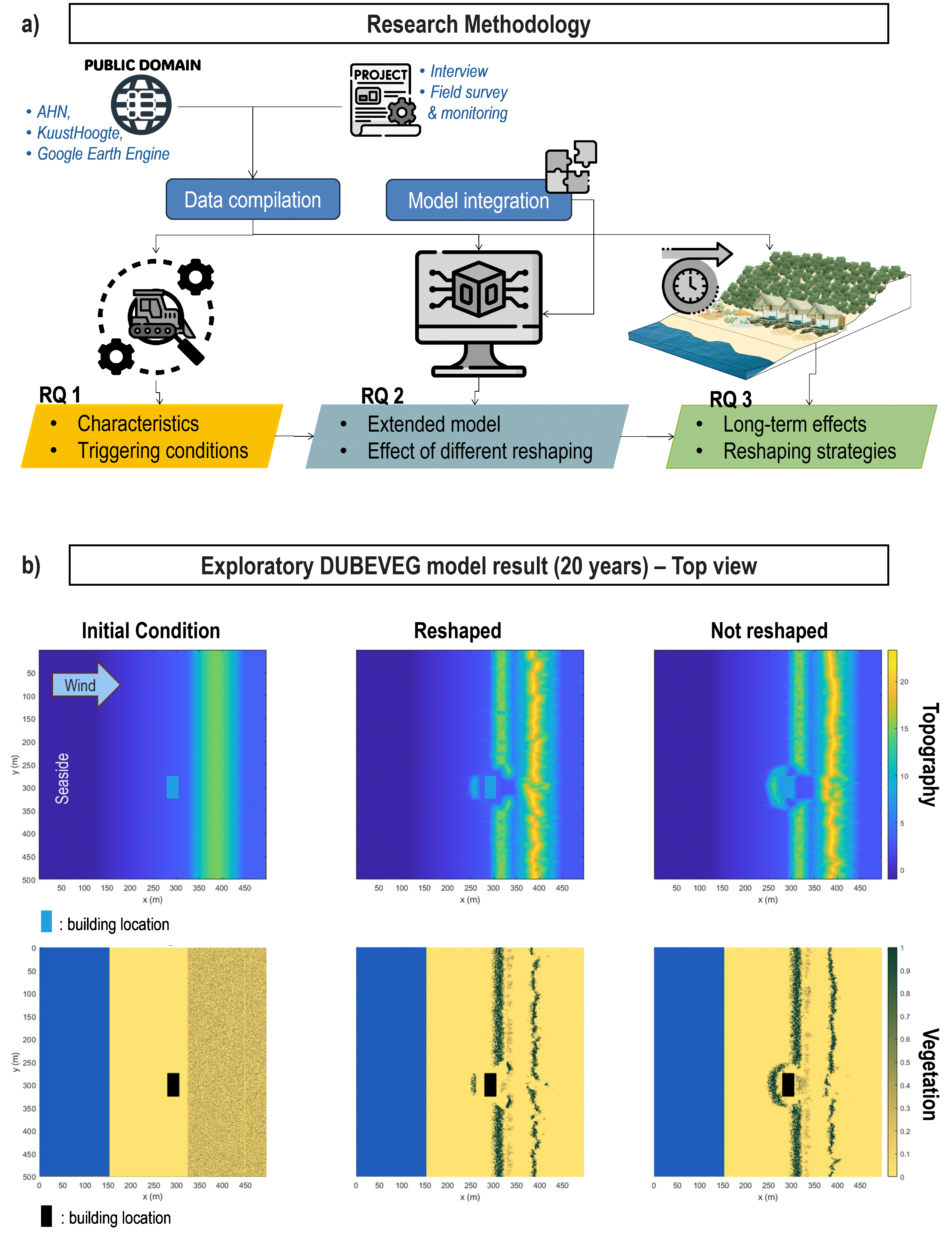S. Florentina1*, G.H.P. Campmans1, K.M. Wijnberg1
1 Department of Civil Engineering & Management, University of Twente, The Netherlands
* Corresponding author: s.florentina@utwente.nl
Introduction
Coastal dunes provide not only a natural barrier against storm surges and waves1) but also provide value for tourism, recreation, and habitat for diverse plant and wildlife species2,3). Amid the growing population, the anthropogenic influences in the beach-dune system will also increase. One example is the mechanical beach reshaping (usually using bulldozers) with various purposes, such as for the placement of seasonal beach buildings4) and the maintenance of recreational beach infrastructures3,5).
While affecting the beach-dune’s morphological processes5), the interactions of bulldozer activity with the beach-dune moprhodynamics are still rarely taken into account, and are thus not understood yet. The sediment flux caused by this bulldozing activity is rarely quantified, nor its long-term effects on foredune development. The available numerical models for beach-dune development do not include bulldozing activity, although in reality their contribution can be critically important in certain conditions6).
In this paper we present an approach for obtaining insights in the long-term effects of mechanical beach reshaping on foredune development.
Objective and Methods
The objectives of our pioneering study on long-term impacts of mechanical beach reshaping are:
- Identifying the various purposes of mechanical reshaping, their interaction with the natural sand dynamics, and their related spatio-temporal characteristics
- Extending a biomorphological model to include the mechanical reshaping as an anthropogenic process dynamically interacting with the natural sand dynamics
- Understanding the long-term effects of mechanical reshaping on foredune development through the extended morphological model.
The developed methodology is summarized in Figure 1a). Data collection for objective 1 will be conducted through interviews and topography measurement which serves as initial basis for the model extension. For objective 2, we will expand the rule-based cellular automata (CA) model DuBeVeG (Dune Beach Vegetation)7). The extension will add the mechanical reshaping activity as a process interacting with natural sand dynamics, i.e. moment and location will depend on various actors’ motivations, that can also be related to the natural sand dynamics. The model will be validated by comparing the topography and vegetation change between the model and various datasets. For objective 3, a range of scenarios will be simulated, to explore the impact of different beach reshaping strategies and different beach-dune lay-outs (e.g. morphology, beach buildings).
Results
A first, exploratory model exercise considered a beach with a box-shaped beach building in front of the dune, with and without some simplified form of mechanical reshaping. Effects on simulated foredune topography (Figure 1b, top panel) and vegetation (bottom panel) development were compared after 20 years. The DuBeVeg version including effects of buildings8) was used as the basis. The reshaping activity was implemented as a yearly bulldozing activity creating a flat area around the building to maintain the building’s accessibility by removing hindering effects of aeolian morphodynamics. The reshaped area was defined as a rectangle with its sides 10 meter from each of the building’s faces.
The simulations showed for both cases the development of a new foredune interrupted by the building’s presence. Without mechanical reshaping, aeolian deposition concentrated upwind of the building while with the reshaping included, the sand accumulated more on the downwind side, accompanied with more dense vegetation in the deposition areas. Impacts of bulldozing activity on topography and vegetation thus clearly extend beyond the bulldozed area itself. For further work, first the implementation of bulldozing activity will be adapted based on outcomes of objective 1.

Figure 1. a) Research methodology for uncovering long-term impact of mechanical reshaping on foredune development b) Results of exploratory modelling of simplified reshaping activity around a beach building simulated for 20 years showing: topography (top) and vegetation (bottom) change for reshaped (middle) and not reshaped (right) compared to the initial conditions (left).
References
- Arens, S. M., Wiersma, J., (1994), The Dutch Foredunes: Inventory & Classification. Journal of Coastal Research, 10(1), 189–202.
- Van Bergen, J., Mulder, J., Nijhuis, S., Poppema, D., Wijnberg, K., Kuschnerus, M. (2021), Urban dunes: Towards BwN design principles for dune formation along urbanized shores. Research in Urbanism Series, 7, 101-127.
- Dugan, J. E., Hubbard, D. M., (2010), Loss of coastal strand habitat in southern California: the role of beach grooming. Estuaries and Coasts, 33, 67-77.
- Nordstrom, K. F., Arens, S. M. (1998). The role of human actions in evolution and management of foredunes in The Netherlands & New Jersey, USA. Journal of Coastal Conservation, 4(2), 169-180.
- Jackson, N. L., Nordstrom, K. F. (2011). Aeolian sediment transport & landforms in managed coastal systems: a review. Aeolian research, 3(2), 181-196.
- Lazarus, E. D., Goldstein, E. B. (2019). Is there a bulldozer in your model? J. of Geophysical Research: Earth Surface, 124, 696–699.
- Keijsers, J. G. S., A. V. De Groot, M. J. P. M. Riksen (2016). Modeling the biogeomorphic evolution of coastal dunes in response to climate change, J. Geophys. Res. Earth Surf., 121, 1161–1181
- Poppema, D. W., Baas, A. C., Hulscher, S. J., Wijnberg, K. M. (2022). Cellular automaton modelling of the effects of buildings on aeolian bedform dynamics. Aeolian research, 59, 100840.










